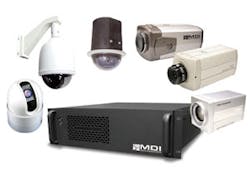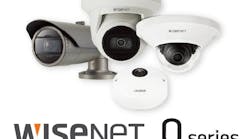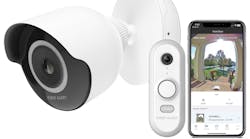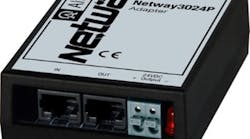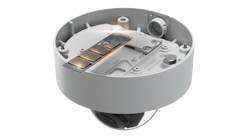Applications and opportunities for video have gone through a revolution in recent times, owing to advances in technology and a heightened demand for security and surveillance in our society.
The term “CCTV” (closed circuit television) was originally a phrase used to differentiate dedicated video surveillance hardware and systems from those designed and used for broadcast applications. It is still used to describe a broad range of equipment and applications.
All television technology was based on vacuum tubes and analog transmission and processing. Cameras utilized vacuum tubes to sense images, convert the signals for transmission, receive signals, convert them for display, amplify the signals and display the signals. I am not sure, but I imagine tubes were even used in early video recorders, although my own recollections only go back as far as videocassette recorders using transistor technology. Videocassettes are just magnetic tape housed in a handy container.
The technology transformation began with the introduction of transistors. The transistor took us across the threshold into the realm of “solid state.” Your floor model radio now could fit in your shirt pocket.
The milestone in video technology was the introduction of the solid-state image grabber, The Charge-Coupled-Device, which replaced the vacuum tube vidicon tube. Vidicon tubes had a host of problems, which became intolerable as soon as the benefits and advantages of the solid-state image grabber were revealed and refined.
The milestone in video acceptance was the fact that there was soon to be television in every home, and they broadcast images that were captured by cameras.
Vidicons were delicate apparatus with filaments and complex architecture. They used a light-sensitive coating that deteriorated over time. CCDs lasted longer and were far more robust.
Vidicon used a lot of power; requiring filament AC voltage as well as high DC voltage. This meant a lot of weight and bulk in the camera, and again sensitivity to a variety of things such as temperature and vibration. Vidicons had a finite lifespan and they also died slowly. From the moment the Vidicon was first powered up, it began to wear out, and the image quality began to deteriorate. Service and performance issues were complex.
The CCD was light and rugged, and generally speaking, it either worked or it didn’t. It weighed comparatively little and used only low voltage DC. CCDs were rated in terms of their light sensitivity and resolution, so the correct Vidicon could be specified for the application, and the performance of the CCD would be predictable and consistent.
Concurrent with the revolutionary introduction of the CCD, was the rapid development of computer technology, networks and the Internet.
The New Video
You can call it CCTV if you want, but it’s more accurate to refer to this realm as New Video. The industry has gone totally digital. The cameras use digital image grabbers and signal processors and communicate via digital network protocols over wire or RF. The images are processed via digital signal processing techniques using both off the shelf PCs and proprietary hardware. Image storage is on hard drives.
Transmission lines, once primarily coaxial cable, are now networks, the Internet or RF links. Recording and archiving of video can be full time so that advanced techniques are at even small video system users' fingertips.
For example, consider pre-alarm recording. With VCRs, image storage capability was a limiting factor. If a cassette ran out of room, then either the recording process stopped until the cassette was manually replaced, the recording process was interrupted while the VCR rewound the cassette and began recording over the cassette, or in high-end sophisticated set-up, the first VCR would sense that its cassette was full, and automatically switch recording to the next cassette recorder. Cascading VCRs was an expensive, complicated and failure-prone set up.
Professional CCTV systems used (use) specialized time-lapse VCRs. These systems have the ability to record at slower speeds to extend the recording time of the tape. Recording at a slower rate means fewer frames per second; therefore, much detail is lost when recording. The analogy was that a time-lapse recording resembled a Charlie Chaplin movie -- flickering and gaps. That’s why they called them ‘flicks.’
In practice, the usual goal was to achieve enough recording capability to span a long weekend.
Professional time-lapse VCRs also had two other features; timed recording and alarm sensors to trigger recording. If the VCR was on a timer, you might very well miss something. For example, if you had the VCR sensing a door contact or a motion detector, you had to hope first that the VCR worked, and then that the VCR would get up to speed in time to catch the action.
Using digital video, storage capabilities are expanded beyond the fondest dreams of the analog CCTV system designer. The camera is always running. If an alarm event occurs, the system can tag it and even if the event is missed when it occurred, the system operator can go back to the point in time when the event occurred, or just slightly before the time the event occurred, to see the entire scenario.
At the time I am writing this article, the bombing has just occurred in London. The city is saturated with digital cameras and uses digital video archiving technology, so there is an excellent chance that some of the events preceding the actual blasts may be available for forensic use.
The new video is cheaper and more powerful than ever before. Since it is based on digital signal transmission and processing, some familiarity with computers and cameras will be an advantage for those endeavoring to supply and install it. But since the equipment is largely “plug & play,” the adjustments and settings are few and easily learned. The software applications used for viewing and otherwise manipulating cameras and archived video are typically Windows®-based and user-friendly. Essentially no high voltages are used except for perhaps the line cord you plug in for the computer, which is 120 VAC.
Opportunities for Locksmiths
The public’s acceptance of new video is therefore greater than ever, and the demand for these systems makes video a possible market for the locksmith.
Video is commonly incorporated into access control systems. Video intercom systems which allow tenants and homeowners to identify visitors before unlocking the door, the building entrance or the parking gate, are becoming more the rule than the exception.
Employers are requesting cameras to be installed in parking areas and elevators to help improve the safety environment for employees.
Cameras also provide additional protection for the owner to help avert frivolous lawsuits. The camera provides the real story of what actually happened. The money saved by avoiding one litigation, one mugging or one vandalism will easily pay for 20 video systems, not to mention the increased sense of well being video surveillance can impart on employees and building occupants.
Locksmiths are service providers, trusted protectors and skilled tradesmen. If you’re currently operating a locksmith operation, you are probably encountering competition. The pages of Locksmith Ledger frequently report the infringements on the locksmiths’ turf from new interlopers. No doubt the competition is indeed fierce; but the demand for security has never been greater and the variety of products the locksmith can offer also grows.
Most locksmiths take their work seriously. They want to do the best job possible for their customers. When I visit a client to discuss a new project, I never miss an opportunity to bid additional products and services. One client who once counted on us for master keying and lockset installations has grown into a 20-door access control installation. We’ve also supplied this account (to date) with eight door operators and an emergency door release system. Last week we got this client to agree to accept proposals for two complete gate operator systems and CCTV cameras.
Some locksmiths don’t want to get involved in non-mechanical related security products. This is understandable because there are others who only want to deal with electronic security. But an inescapable fact is that for the last 30 or so, years security solutions have become hybrids; combining physical and electronic security technologies to provide the most concise protection for people. New video is an integral and exciting element in this process.
